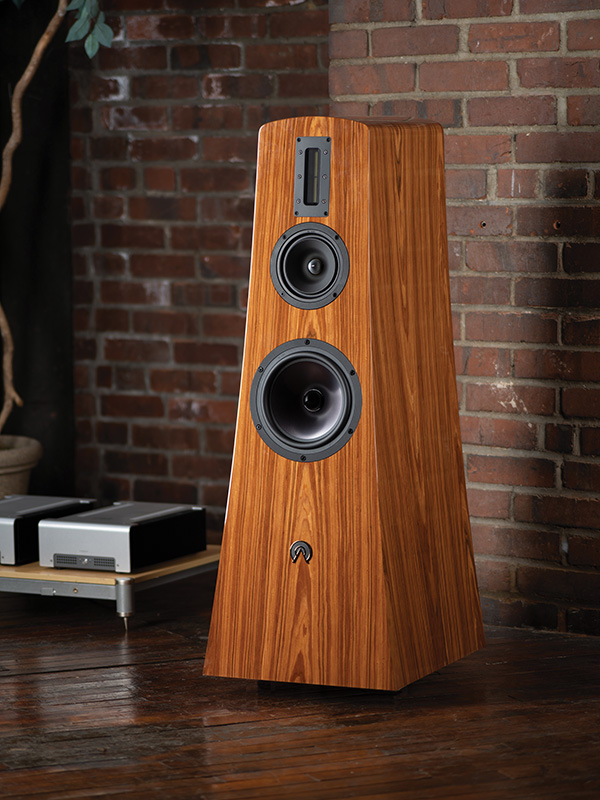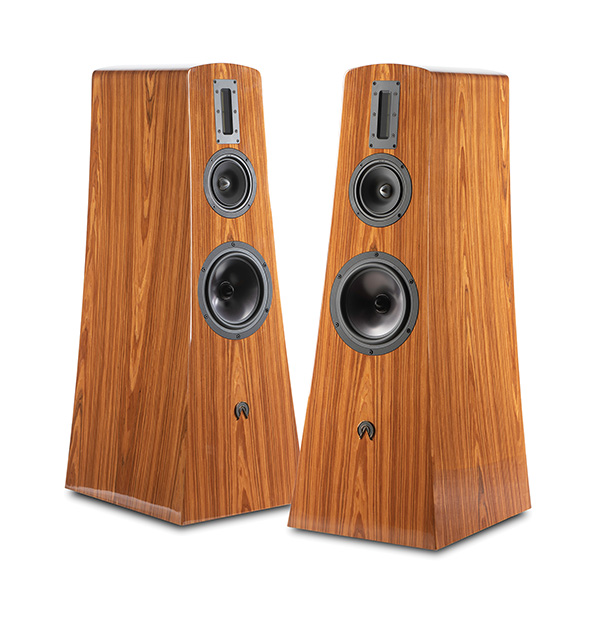| Columns Retired Columns & Blogs |
these medium-sized towers sound, in a word, right
No way, not with those measurements.

A hint of ashiness? More like 15 hints of pretentiousness, I thought. I sent the paragraph to a few friends with the request, "If I ever start jabbering like these coffee cognoscenti, I want you to punch me in the taint. Hard." We laughed and moved on.
I had enough self-awareness to realize that in the hi-fi world we sometimes prattle on about hi-fi in ways that, to outsiders at least, must seem just as fustian and florid. With every Stereophile review I write, I feel a little belated sympathy for the coffee reviewer. It is maddeningly difficult to be precise about the intricacies and nuances our senses perceive. Just like the argot in The Wine Advocate and Artforum, audio reviewers' prose can seem swollen, posey, and poncy.
In this assessment of Alta Audio's Adam speaker, I could cut down on the high-flown lingo, because these medium-sized towers sound, in a word, right. The treble, for instance, is not dry or bright: It's right. But I have a responsibility to go further than that, to say what it actually sounds like. During my copious notetaking, I struggled to describe this speaker accurately. It occurred to me that the better the audio product, the harder it is to describe. Truly outstanding speakers and components are special because of what's not there: sibilance, honkiness, chestiness, tizz, tubbiness, and so on. So, I wracked my brain: What else is like this? What's another thing that reveals its character mainly by the absence of imperfections? I never found the right simile—suggestions are welcome—but during the six weeks I spent with the Adams, that's what I kept reaching for.

Arrival, appearance, setup
The Adams arrived, strapped to a pallet, on a freight truck. If that conjures up a pair of gargantuan, room-dominating speakers, you'll be pleasantly surprised. At 41" tall, with a tapered, curvy profile and a weight of 96lb each, the Adams look substantial but not overpowering. The finish on my pair was a limited-edition silvery gray. "That's the same paint Lexus used on its 2004 vehicles," Mike Levy, Alta Audio's founder, told me over the phone.
When I asked, he recommended that I use my Townshend Seismic Isolation Podiums (footnote 1) to decouple the Adams from the hardwood floor in my listening room, whose boards are nailed into joists positioned over a 6'-deep basement. Levy also recommended using the supplied two-stage conical spikes right on top of the Podiums, which raised the ribbon tweeters well above ear level. With Levy's approval, I tipped up the Adams' rears, extending the rear spikes as far as they would go, pointing the speakers down at my ears. I measured a 3.8° forward tilt. (Those spikes screw apart along a threaded center stem, allowing the user to vary the height from roughly 1.5" to 2.5"—a nice little feature that can also be used to level the speakers in case of uneven floors.) Levy told me that if my floor had been laid over solid concrete, I'd probably get the best results with the spikes installed but without the Podiums.
I used the Bubble Level app on my iPhone to make sure the Adams were laterally level. After some experimenting, I settled on mild toe-in, the imaginary straight lines emanating from the drivers crossing about 20" behind my head. I had the Adams 6' 10" apart (measured from the centers of the drivers), their backs 3' from the front wall, their outer flanks 3' 4" from the side walls, and their ribbon tweeters at a distance of 10' 2" from the tops of my pinnae, as affirmed by my Bosch Blaze laser measure.
Just when all seemed almost right for extended listening, something unexpectedly tied my stomach in knots. As I moved the spiked right speaker a few millimeters on the metal Townshend plate, a small, flat piece of MDF broke away from the Adam's rear bottom, around the rightmost thread insert. I experienced roughly the feeling you get when you accidentally smash a flagship smartphone—but 20 times worse because a pair of Adams costs about 20 times the price of that bauble.
I took a closer look. The drill hole in question was only 0.15" from one edge and at most a quarter inch from the other—perhaps too close to the corner. Two-stage spikes that are screwed apart and extended (per Alta Audio's instructions) are not as stable/tight as spikes that are fully screwed in. If the weight of the heavy-ish speaker is partially borne by that slightly wobbly spike, and if the cabinet material is MDF—a good, inert material for a loudspeaker in most other respects—chipping or breaking may occur. Levy talked to his manufacturing team the same evening I emailed him photos that showed what had happened. The crew addressed the issue in two ways. "We instituted a modification that both reinforces the bottom structure that holds the feet and changes the bottom-plate material to a higher-density material," Levy explained. "We have also moved the insert for the feet deeper into the hole. Our tests moving the speakers around have not shown any problem after this fix."
Alta Audio's warranty promises to take care of any quality issues for half a decade after purchase, upon registration.

Drivers and materials
Levy piqued my curiosity when he claimed that the Adam's pure-aluminum ribbon tweeter, which is almost 6" tall and features a magnesium case and neodymium magnets, is "greater than the sum of its parts." A pinkie's breadth below the tweeter housing is a 6" midrange driver, and a little farther down is a single 8¾" woofer, which alone is responsible for a frankly astonishing amount of tight, penetrating bass. We'll get to that.
Alta Audio's website claims that the wideband midrange driver, which was designed in-house, is "underhung for exceptionally low distortion and ultra-fast transient response, while its aluminum pole increases dispersion." If the claims are true, the wideband moniker is more than justified: this transducer can, it is said, handle 50Hz–20kHz, but Levy decided to cross it over from below and above at 250Hz and 2.25kHz. That should allow for "a wide, linear crossover range," he said, with smooth transitions from bass to mids to treble.
The woofer, outfitted with a black anodized cone, is the key component in the patent-pending "XTL" design, with a low-loss rubber surround and magnet boot plus a solid-aluminum phase plug. XTL stands for eXtended Transmission Line, an Alta-exclusive technology that, according to the company's website, "applies sonic geometry to tune speaker cabinets as if they are musical instruments, delivering an accurate, fast, and powerful low frequency response."
Levy was inspired by several influential 1970s papers on loudspeaker design co-written by Australian sound engineer Neville Thiele and American electroacoustician Richard Small, of the well-known Thiele-Small parameters (footnote 2). He expanded upon that duo's insights with a few of his own. Boxes, he said, create standing-wave resonances that degrade sound, which leads loudspeaker designers to use absorptive materials inside to smooth out the response. "I reasoned that the padding may be the problem," Levy ventured. "Looking at instrument design, there are similarities between how a cello or a standup bass is designed and what's done in a loudspeaker. The strings act as the driver, and the cavity is used to amplify them into the lower frequencies. Panel resonances create the sound character of the instrument. Eliminate the panel resonances, and you have something very similar to a loudspeaker."
So, Alta Audio skips the padding and builds its cabinets out of a proprietary material it calls DampHard, touted as a "multi-layered, multi-density material," which is used on the driver board of the Adams. While standard MDF would let certain frequencies resonate, Levy said, DampHard is claimed to "remain dead to virtually all vibration." Levy noted dryly, "I've never seen anyone put padding in their Stradivarius to make it sound better." Fair point (footnote 3).
He's also never seen a classical instrument shaped like a box. "The shaping of instruments is not for looks or convenience," he observes. "It's to create a smooth musical sound." Similarly, Alta Audio's six current speaker models have tapering lines and graceful curves in the service of a single goal. "When you experience great performers in a close setting, you feel every note as it goes right through you. You resonate with the performance and, in effect, become part of it. From the inception of Alta, I wanted to reproduce that feeling, going beyond palpable imaging and tonal accuracy to put you in the venue, sitting in the best seat."
Rounding out the Adam's topography are two smallish rear ports per side, one near the top and one at the bottom, and two pairs of shielded five-way binding posts with factory-installed jumpers, which you'd remove should you decide to biamp the Adams.

Footnote 2: See en.wikipedia.org/wiki/Thiele/Small_parameters.
Footnote 3: I've long found the analogy between loudspeakers and musical instruments flawed. The reason is simple and, to me, obvious. The goal of a string-instrument designer is to create a device that transforms a string's vibrations into rich and interesting sound, while the goal of a loudspeaker designer is to create a device that accurately reproduces a record of a sonic event. The loudspeaker designer has an obligation to fidelity that the instrument-maker doesn't share. When a quality violin plays a G5, the second harmonic is down just 5dB or so compared to the fundamental.
There's another part of me, however, that suspects that the very best components, including loudspeakers, manage to transcend mere fidelity and deepen our experience of listening. Whether that has anything to do with loudspeakers acting like musical instruments, I have no idea.—Jim Austin

these medium-sized towers sound, in a word, right
No way, not with those measurements.

That's being diplomatic.
Cheers George

...jacket material to cover your speaker cable, or adding an Ikea cutting board under each of your components makes a difference to the sound of your system, then building and "tuning" your speaker like a musical instrument makes sense, too.

I find Alta audio speakers to sound very good at shows also. Maybe it's better not to know how something measures if you like the sound?

Listen at Presentation in VPI house, Huge soundstage Very controlled bass
Excellent speakers

This level of piss-poor engineering wouldn't be acceptable on a $300 pair of speakers. What a joke. I suggest the reviewer listen to music on actual high fidelity speakers to calibrate what good sound actually is. Good grief.